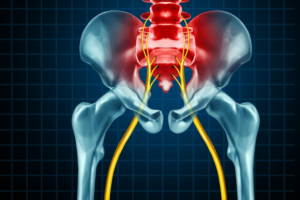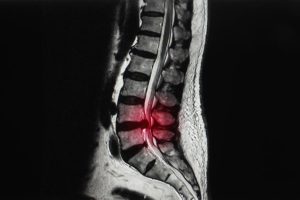What is Sciatica?
The term sciatica is used to describe pain that shoots down your leg. Sciatica can affect the back, hip, and outer part of the one or both legs. Pain can be constant, come in jolts or can be spurred on by certain movements such as getting up off a chair.
Causes of Sciatica
Sciatica is usually caused by pressure placed on the sciatic nerve that runs down your leg. The reason for the pressure can be due to the following:
Herniated/Slipped Disc
This is the most common cause of sciatica. A herniation occurs when the disc splits and the gel-like substance comes out. When this happens, it can put pressure on nerve roots, causing pain. If this herniation happens in the lumbar spine the pressure could be placed on the sciatic nerve, causing sciatica.
The piriformis is a muscle that attaches the lumbar spine to the femur (main bone of the thigh). The sciatic nerve connects to nerve roots in the lumbar spine and runs down your leg. This nerve should normally run below the piriformis and if the piriformis is irritated (inflamed) it could cause a literal pain in the butt and possibly put pressure on the sciatic nerve. 
Spinal Stenosis
If the cavity in which the spinal column is housed is narrowed (stenosis), pressure could then be placed on the spinal column causing pain. This usually occurs in the lumbar spine (lower back) and can cause sciatica.
Spondylolisthesis
Spondylolisthesis occurs when one vertebrae slips forward over the one below it. This can cause spinal stenosis, sciatica, or both. Similarly to spinal stenosis, it usually occurs in the lower back.
Treatment for Sciatica
Treatment for sciatica will be determined by the cause and can include:
- Spinal Decompression Therapy
- Resistance exercises to strengthen the muscles around the spine
- Medications
- Epidural Injections
In need of Sciatica therapy? Schedule an Appointment Today!
If you have any questions, or want a consultation with a professional, feel free to call, or schedule an appointment online at any of our Bergen County or Passaic County offices in New Jersey. Choose from Glen Rock, Franklin Lakes, Fair Lawn, Ho-ho-kus/Ridgewood, and/or Clifton – we make it possible for you to visit any of our offices at your convenience.
Many of the conditions listed above are caused by weakness in the back, specifically the lumar region. That being said, there are preventative measure you can take to avoid sciatica. Examples include:
- Practice Proper lifting techniques
- Exercise regularly
- Strengthen your glutes
- Strengthen your abdominals
- Lose Weight
- Avoid cigarettes(helps prevent degenerating discs)
- Learn proper posture and practice regularly
- Don’t sit for too long
- Regular massage or Self Myofacial Release (SMR or Self Massage)
- Make sure to get adequate amounts of Magnesium in your diet (it helps prevent muscle spasms)
Do you suffer from Sciatica? Contact Us To Schedule An Appointment Today.





